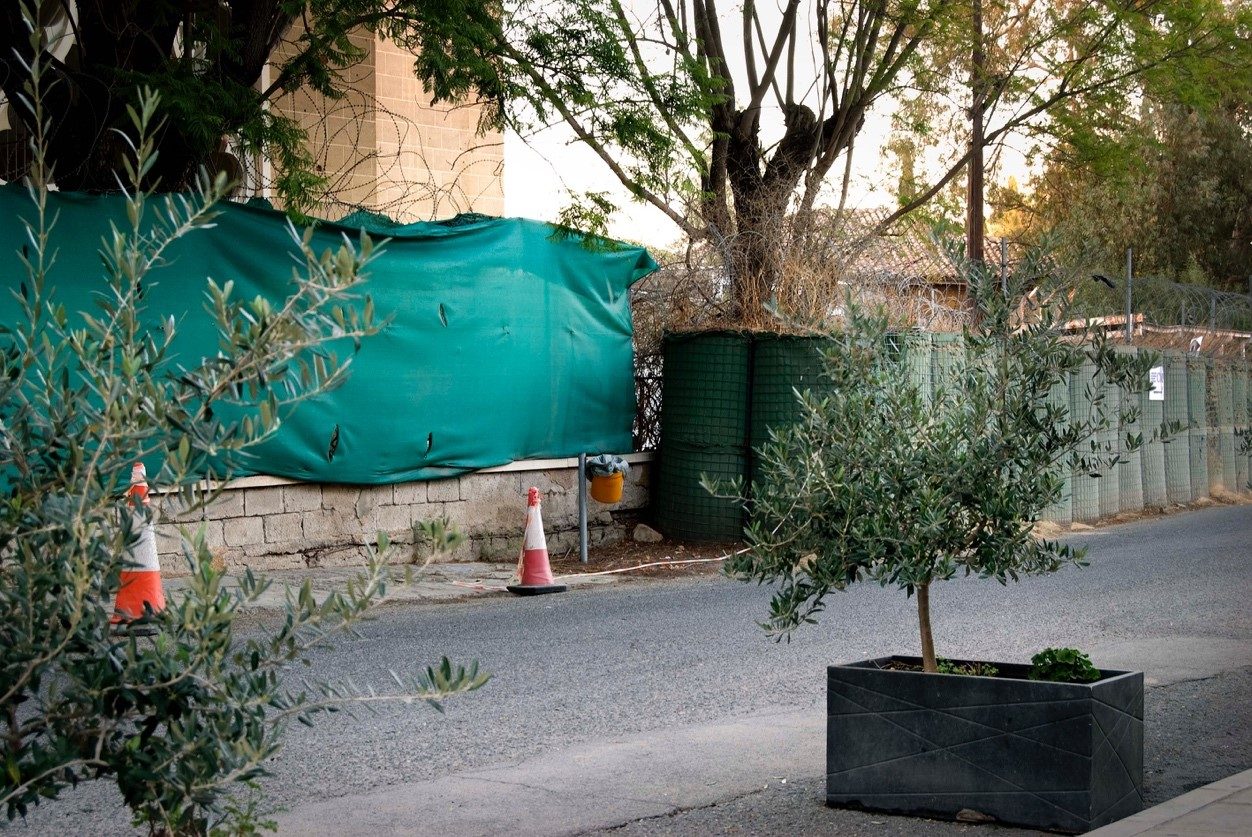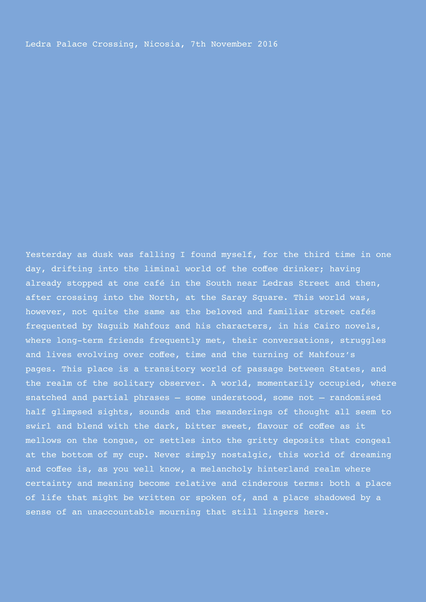We had sat ourselves down, each with a small cup of sweet coffee before us on a long rough-wood trestle table, along whose centre stood a row of small potted cacti and succulents. The table surface appeared as if a metaphor for the political divide, the UN demilitarised Buffer Zone, in which we were now sitting. J had his back to the road and faced a building he knew well, having photographed in the area over a six-year period between 1998 and 2004. When he last saw it, however, it was an abandoned and dilapidated ruin, and only the roof area was used to situate a UN observation post. A solitary sign on the building’s façade had once announced that at some past time the building had housed a T-shirt printing shop. That sign has now gone and the building, part of a programme of regeneration and transformation along the road, has become the Home for Cooperation between the two divided communities. Whether we coffee drinkers were drinking Cypriot, Greek or Turkish coffee was a moot point.[1] A few groups of people and one other individual, like ourselves, now sat at the various tables to meet, talk or simply to absorb the last of the late afternoon sun: chatting or waiting as the day slipped towards that still moment after sunset and before the maqam ordered refrain of the maghrib azan sounded across the city.
Up to 2003 this border crossing had been the only permitted route between the North and the South and, at that time, stopping to spend time or to rest was not really a comfortable option. This short stretch of road, some 200 or so metres between the South and North Cyprus border control points, was one strictly for passage and movement. The sights – could one call them that? – on either side were things to be stolen furtively in a kind of guilty glance. This state, seemingly and for some time, had changed. Stopping or pausing was now a possibility. Sitting and facing east, as J was, the Buffer Zone stretched out of sight behind the Home for Cooperation, down a slope freely colonized by wild and cultivated plants, among them the tall flower stems of the Agave, introduced from Mexico in 1640.[2] The view extended onto and across a flat, barren stretch of land (a dry moat) until it reached the antiballistic ramparts, built when the Venetians occupied Cyprus in the C16th, and then into Nicosia’s old Armenian quarter of Arabahmet. Behind him, roughly to the west, and stretching almost the whole way between the Turkish and Greek Cypriot checkpoints, stood the imposing bulk of the Ledra Palace. It was still partly hidden at the ground floor level behind long sheets of the semi-opaque dark green fabric that may be found along many other stretches of the Buffer Zone. The Palace, formerly a hotel designed by the German Jewish architect Benjamin Günsberg, built between 1947-1949 had become, since 1974, the barrack building for the UN troops of Sector 2. After 40 years, the marks of bullets and shrapnel still scar its walls. Its once extensive gardens, with swimming pool, tennis court and crazy golf course, lie within the dominion of the UN authorities. Occasional snatches of music coming from within the building drifted, through one or other of the Palace’s many windows, down to us at the café.
At the time of J’s last visit here in 2004, the other remaining buildings and the gardens that lined the eastern side of the Ledra Palace crossing – decaying relics screened behind more than 30 years of encroaching vegetation, the merest shells of buildings folded within small but growing wildernesses – had now been drawn back from their state of abstraction and had been tidied up, not restored, but consolidated and cleansed. The evidence of conflict or post-conflict, the loopholes, sandbags (many made from coffee-bean sacks), the barbed and razor wire had all but gone. The area had been made palatable to the eye and a certain, if unreal, aspect prevailed along the short stretch of road, suspended as it still is between the two checkpoints and beside the designated UN Exchange Point.
The overarching stillness, along with the hushed, private conversations of our fellow coffee drinkers – their intakes of liquid, their breaths, occasional muted words and the slow unfolding silences – seemed wholly appropriate both to the locality and the time of day. Yet, what had formerly been a thriving international hotel and thoroughfare, then a forty-year-long unhealed wound, an urban green (line) wilderness, was again beginning to stir to winds that emanate – eddy too – around humans, their everyday interactions, and to history (to occidental history). The road, its environs – the localised wilderness and the decay – from which a larger world history may, at times, have seemed to have all but slipped, was becoming again subject to its wider influences and intrusions.
[1] Many individuals have drawn this parallel between coffee, cultures and naming as a pointer to the superficiality of adversarial states of difference. In this instance we are thinking of sentiments made in the poem, ‘The Coffee’s Name’, by the Cypriot poet, Kyriakos Sorokkou, from his self-published book, The Muses and Other Poems (2015), 71.
[2] In Mexico the sap of Agave Americana is used to produce the alcoholic beverage, pulque, which is also know in its distilled form as mescal.
Postscript:
An article which talks about the Home for Co-operation and its significance in shifting attitudes towards the division of the island of Cyprus, also notes the imminent closure of Ledra Palace as a UN barrack building due to dilapidation and infestation. Over the course of 2019 the current contingent of peace keeping soldiers are to be rehoused in a new camp of container homes behind the hotel. 14 April 2019, The Observer, p40.

